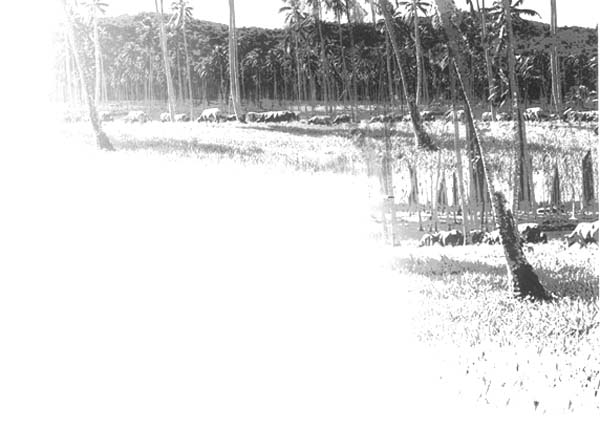
Table 1
Notes
Cattle smallholdings can involve aggregations of households particularly in Vanuatu.
Largeholdings or plantations or estates have > 400 cattle in Papua New Guinea and > 100 head elsewhere.
Following partial dispersal of Nawaicoba cull ewe flock to smallholders, 20% annual increase is expected.
For New Caledonia, the rural population of 69 000 comprises 11 000 households (FAO 1997a) based on a regional rural household size of 6.3.
2125 farms from Marchal et al. (1993); 1500 cattle farms have < 50 head, 20 farms > 500 head.
120 of the farmer 200 registered pre-independence plantations in Vanuatu raise between 100 and 11 000 head, averaging approximately 660 per plantation, and approximately 30 local smallholders would raise in excess of 100 head (Skea et al. 1993).
Sources
General: FAO 1997a. Fiji: MAFF (1994). Tonga: MAF (1994). Samoa: MAFFM (1989, 1997). Vanuatu: Statistics Office (1994) and most recent country census and smallholder survey figures and annual reports. Papua New Guinea: Banguinan et al. (1996). Solomon Islands: Wate (1996); MAF (1994, 1995) internal reports.
Table 2
Sources
General: FAO 1988, FAO 1997a; personal communication with senior livestock officers; recent Livestock Division periodic / 1994–1995 annual reports; 1994–95 Statistics Office reports. New Caledonia: Marchal et al. (1993). Papua New Guinea: Banguinan et al. (1996); Gama et al. (1991). Solomon Islands: Wate (1996). Samoa: Macfarlane (1996); WSTPLSP Review (1995). Vanuatu: Evans et al. (1992); Macfarlane (1996).
Notes
In Fiji cattle numbers have been adjusted downwards from 354 000 to 280 000 due to preceived inflated statistics based on disease surveillance cross-checking. Recent (1988) SPC disease survey data suggest an approximately 50% reduction in Solomon Islands cattle numbers.
12 000 deer are enclosed and farmed commercially while an estimated 110 000 are feral forming basis of commercial hunting industry (Corniaux & Sarrailh 1997).
M. Purea, FAO SAPA Office, pers, Comm.
P. Saville, SPC, Suva, pers. comm.
Table 7
Sources
Fiji: MAFF (1994) AHP report; Papua New Guinea: J. Mandich, Livestock Development Corporation; FAO (1997a). Solomon Islands: MAF Livestock Division report (1994). Tonga: MAF Livestock Division report (1994). Vanuatu: Livestock Department annual report (1994); Statistics Office report (1994); Samoa: Livestock Division reports (1997); WSTPLSP Review (1995).
Projections and key assumptions
Projections are totally dependent upon the accuracy of key assumptions. The most important assumptions in this discussion revolve around:
expectations of farmer response to improved extension delivery, training and on-farm demonstration of alternative technologies and practices;
exceptions of government support for farmers;
exceptions of livestock product market prices and production costs relative to other enterprises and market opportunities.
Specific assumptions
Farmer response and production expansion
Projections of areas and associated livestock receiving improved system management are based on outcomes from previous projets including 34 of 35 FAO farmer trainees undertaking 400 ha pasture improvement in one year (see chapter 5); 32 of these trainees (smallholders) committed to 3000 ha pasture improvement over ten years; estimates of 35% ni-Vanuatu and 60% plantations adoptive after five years, and expectations in Samoa following the STPLSP project.
The rates of pasture establishment over the respective timeframes for each country to reach beef self-sufficiency at nominated 1994–1995 levels of imports (10 to 20 years, see Section 4.2 and Table 6) are achievable, given the application of available mechanical and manual pasture planting technologies and reliable supplies of locally produced and imported seed.
Animal unit stocking rates used in calculations in Table 8 are proven for respective open and shaded grazing systems.
It is assumed that farmers who do adopt new technologies will apply the full spectrum of recommended, cost-effective forage and grazing animal management technologies across the grazing resources specified.
Government support
It is assumed that:
governments implement integrated production and marketing assistance programmes;
governments implement improved extension delivery and farmer training programmes which are responsive to farmers needs;
government policies are conducive to institutional support and the maintenance of positive domestic marketing environments.
Livestock production costs and market prices
It is assumed that:
gross margins for best practice grazing livestock systems do not significantly deteriorate relative to cropping or other enterprise alternatives;
development credit is available for creditworthy, adoptive or potentially adoptive farmers;
the present non-limiting animal health status of forage-based livestock continues.
Other aspects
It is assumed that:
attaining 1994–1995 beef import levels of self-sufficiency will not create land-use conflict with competing enterprises;
livestock development does not take place in ecologically sensitive areas;
livestock system management in existing and new areas conforms to environmentally acceptable codes of practice;
expansion beyond nominated levels of livestock production is guided by the needs of subsistence and commercial cropping systems for lands of high production capability, to meet the needs of expanding populations.
